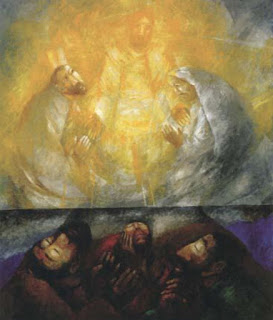Luminous Mystery—The Transfiguration [9 of 20]
 |
| Transfiguration by Sieger Köder |
F
ourth Luminous Mystery—The Transfiguration. And He was transfigured before them, and His face shone like the sun, and His clothes became dazzling white. Suddenly there appeared to them Moses and Elijah, talking with Him (Mt 17:2-3).
We come to another mystery that apparently the connection with the Blessed Virgin Mary is dimmed. But if we contemplate deep into the mystery we will soon discover. Transfiguration is an English word, but its components are all Latin. The prefix trans—means across and, by extension, to change. For example, the word "transport" literally means to carry across. When one transports something, he or she carries it across to another place which results in a change of place or position. Transfiguration has a root word "figure"—some sort of shape or form, like that of a human shape. In Matthew's gospel account, the original Greek word used Της Μεταμορφωσευς (Tis Metamorfoseus) is the same word as what we now have in English as "metamorphosis." Jesus's transfiguration has the same organic elements in order for the biological transformation of the caterpillar into a beautiful butterfly to take place. Like the Latin counterpart, metamorphosis is also to carry across. But if rendered in English metamorphosis literally means transformation. The Church did not use it as a substitute for Transfiguration in English because the meaning of transformation not only that it is too broad referring to just any sort of change but it is also too narrow as it connotes the bio-physical change such as the same crawling caterpillar emerging from the cocoon but with wings, or from Franz Kafka's novel The Metamorphosis and the horror of a man, Gregor Samsa, transforming from human to insect.
At this point, we can take a look back—way back during the annunciation of the angel to Mary. At first, Mary did not fully understand what was told to her—how the whole plan of God would play out. But throughout the whole thirty-three years of accompanying Jesus, Mary gradually found the answer to a litany of her questions that began from her question to Archangel Gabriel, "How can this be since I do not know man?" Mary's understanding of the mission and identity of Jesus morphed along with Jesus's transfiguration from conception until the Passion, Death, and Resurrection. In a deeper, richer, and even more organic way, we can view the mystery of the Transfiguration of Jesus as a gradual process rather than just a one-time event.
Let us use the structure of a story as an analogy. There is no story without a plot just as there is no butterfly if there is no egg. Even if you have a very brilliant idea or a powerful message, without a plot then it will never materialize. That idea or message no matter how great the potential is to touch the lives of people must first be transported through a good story with a good and complete plot. There are five elements to a good plot. First is Exposition where the characters are introduced and the setting established in aid of building the primary conflict of the story. Second is the Rising Action; third, Climax; fourth, Falling Action; and fifth, Resolution or Finale. Mary had such a unique privilege among all human beings for she was the only one who witnessed all these five elements "shine" or play out right under her nose. Most mothers are fond of making predictions about the future of their own children—what they will someday become, the butterfly that they will metamorphose into. Mary was not exempt from that.
Fr JM Manzano SJ

Comments
Post a Comment
Thank you for your interest in the above post. When you make a comment, I would personally read it first before it gets published with my response.